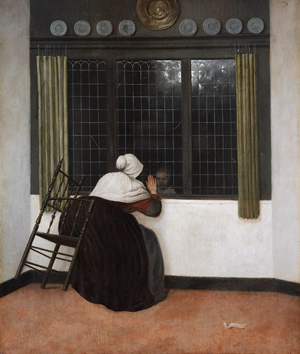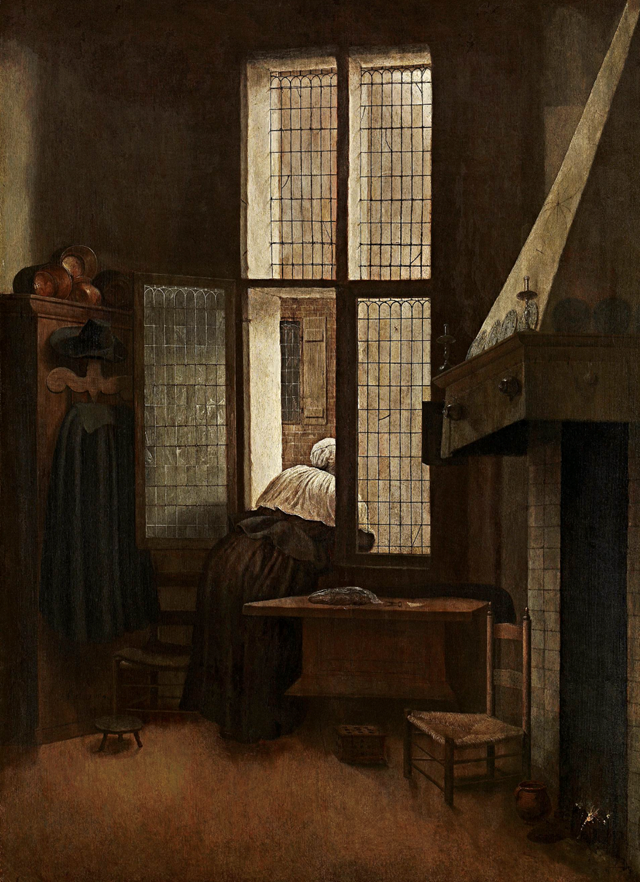
Everyone knows Vermeer’s quiet interiors and that one Little Street, but few people know that artist Jacobus Vrel was already producing scenes of this kind before the paint was dry on Vermeer’s first masterpiece.
Everyone knows Vermeer’s quiet interiors and that one Little Street, but few people know that artist Jacobus Vrel was already producing scenes of this kind before the paint was dry on Vermeer’s first masterpiece.
In an exhibitiont titled Vrel, Forerunner of Vermeer, the Mauritshuis will share the story of this mysterious painter, showing 13 paintings from collections in the Netherlands and abroad to introduce visitors to Vrel and his work. The famous Kunsthistorisches Museum in Vienna has loaned us two extraordinary paintings, one of which is Woman at the Window (1654), the only dated work by Vrel. The Mauritshuis will host Vrel, Forerunner of Vermeer from 16 February to 29 May 2023, after which it moves on to the Fondation Custodia, Frits Lugt Collection, in Paris, our exhibition partner.
 Jacobus Vrel, Woman Leaning out of a Window, 1654. Vienna, Kunsthistorisches Museum
Jacobus Vrel, Woman Leaning out of a Window, 1654. Vienna, Kunsthistorisches Museum
We know very little about Jacobus Vrel. We do however know that he made around 50 paintings, most of them domestic or street scenes. Woman at the Window from Vienna and two other paintings by Vrel were once part of the collection of Archduke Leopold Wilhelm of Austria (1614-1662). A 1659 inventory is the only contemporary source of information on the painter. Research on the panels has revealed that Vrel was active as a painter long before 1654, much earlier than Delft masters Vermeer and Pieter de Hooch. For a long time, several paintings by Vrel were actually attributed to Johannes Vermeer. The two artists depicted the same subjects, as well as sharing the same initials: JV. Full signatures by Jacobus Vrel were in some cases even turned into Vermeer signatures. Two works in the exhibition – Street Scene with a Bakery by the Town Wall, Probably Waterstraat in Zwolle from Hamburger Kunsthalle and Old Woman Reading, with a Boy behind the Window, now part of a private collection – were sold in the 19th century as ‘Vermeers’.
Many of Vrel’s paintings feature one woman standing by a window in a room with a high ceiling, or seated beside a fireplace. She wears distinctive clothing: a dark dress and a white shawl. Her face is often hidden from view. Using these distinctive features, Vrel created his own world. The sometimes flawed perspective gives the pictures a naïve charm, prompting viewers to pay more attention to the details: the broken panes in a window, or a small white scrap of paper in the corner of a room, bearing the painter’s signature. Vrel made several copies of his own paintings, including the smallest details. Copying was a common practice among 17th-century Dutch painters, particularly portraitists. Why Vrel did this is not known, though it is a simple way of increasing one’s production.
Who was Jacobus Vrel? To discover more about him, an international research project was set up involving three museums: the Alte Pinakothek, Bayerische Staatsgemäldesammlungen in Munich; Fondation Custodia, Frits Lugt Collection in Paris; and the Mauritshuis. The three museums commissioned dendrochronological analysis (study of tree rings to date wood) of several paintings. It revealed that they are older than was thought. Vrel probably started painting the street scenes in 1635-1640; the earliest interiors date from a few years later. In order to determine his location in the Netherlands, the topography of the streets in his paintings was analysed. Researchers Dirk Jan de Vries and Boudewijn Bakker, who studied the small streets and façades in the paintings, now assume that some of the streets are in Zwolle. Infrared reflectography* and X-ray fluorescence** revealed several ‘pentimenti’ (changes made by the artist himself). Vrel had changed or painted out figures, for example, including a child in a street scene from the Rijksmuseum collection. This was a way to perfect his compositions. All the research results have been presented in the monograph on Vrel published by the Mauritshuis and its partners in the study (available in English, French and German editions).
One distinctive feature of Vrel’s work is the way he signed his paintings. He had what might be regarded as his own ‘trademark’, in the form of a scrap of white paper on the ground, which appears in several paintings. Vrel’s signature is written on this scrap of paper. Research has shown that he used several versions of his signature, including ‘J V’, ‘J Vrel’, ‘Jacobus Vreelle’ and ‘Jaco / büs / frell’, the German spelling of his given name suggesting he may have lived closed to the German border at some time.

ArtDependence Magazine is an international magazine covering all spheres of contemporary art, as well as modern and classical art.
ArtDependence features the latest art news, highlighting interviews with today’s most influential artists, galleries, curators, collectors, fair directors and individuals at the axis of the arts.
The magazine also covers series of articles and reviews on critical art events, new publications and other foremost happenings in the art world.
If you would like to submit events or editorial content to ArtDependence Magazine, please feel free to reach the magazine via the contact page.